
ADHD Basics
What Is ADHD?
Attention deficit hyperactivity disorder (ADHD) affects children and teens and can continue into adulthood. ADHD is the most commonly diagnosed mental disorder of children. Children with ADHD may be hyperactive and unable control their impulses. Or they may have trouble paying attention. These behaviors interfere with school and home life.
It’s more common in boys than in girls. It’s usually discovered during the early school years, when a child begins to have problems paying attention.
Adults with ADHD may have trouble managing time, being organized, setting goals, and holding down a job. They may also have problems with relationships, self-esteem, and addiction.
Symptoms in Children
Symptoms are grouped into three categories:
Inattention. A child with ADHD:
Is easily distracted
Doesn’t follow directions or finish tasks
Doesn’t appear to be listening
Doesn’t pay attention and makes careless mistakes
Forgets about daily activities
Has problems organizing daily tasks
Doesn’t like to do things that require sitting still
Often loses things
Tends to daydream
What Causes ADHD?
No one knows exactly what causes ADHD, but certain things are known to play a role.
The Family Connection
ADHD runs in families. Anywhere from one-third to one-half of parents with ADHD will have a child with the disorder. There are genetic characteristics that seem to be passed down.
If a parent has ADHD, a child has more than a 50% chance of having it. If an older sibling has it, a child has more than a 30% chance.
Pregnancy Problems
Children born with a low birth weight, born premature, or whose mothers had difficult pregnancies have a higher risk of having ADHD. The same is true for children with head injuries to the frontal lobe of the brain, the area that controls impulses and emotions.
Studies show that pregnant women who smoke or drink alcohol may have a higher risk of having a child with ADHD. Exposure to lead, PCBs, or pesticides may also have a role.
How Common Is ADHD?
Many reports estimate that anywhere from 5% to 8% of school-age kids have the disorder. But the CDC now puts it at 11%.
Some studies have relied on parents saying that a health care provider told them their child has the disorder. But that doesn’t necessarily mean that the child meets all the criteria for the condition, says Craig Surman, MD, co-author of Fast Minds: How to Thrive if You Have ADHD (Or Think You Might).
Some doctors might give children an ADHD label even when they may have another educational, behavioral, or mental issue. The flip side is that some kids who truly have the disorder aren’t getting diagnosed with it.
ADHD in Adults?
ADHD is not just for kids. About 60% of children who have ADHD still have it when they grow up. Adult ADHD can affect work, relationships and other aspects of your life.
ADHD Types
3 Kinds of ADHDThere are three types of ADHD: Inattentive (formerly called ADD), hyperactive-impulsive, and combined.
Inattentive ADHDThe symptoms of inattentive ADHD may include daydreaming, disorganization, and careless mistakes.
Hyperactive-Impulsive ADHDFidgeting, nonstop talking, and impatience are among the symptoms of Hyperactive-Impulsive ADHD.
